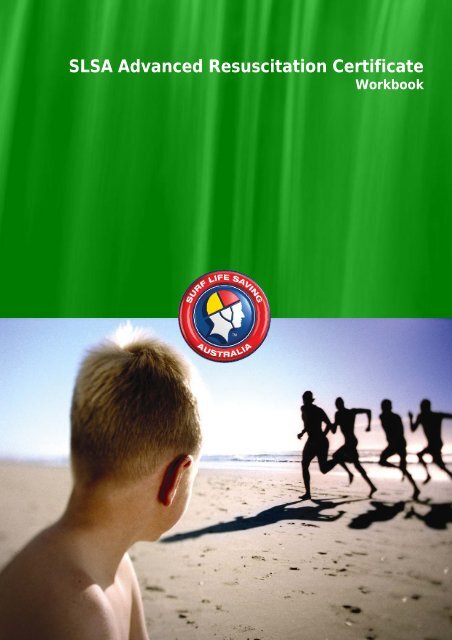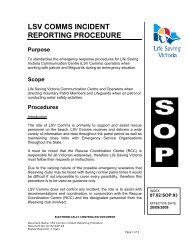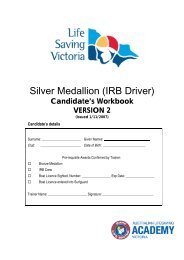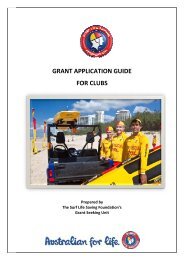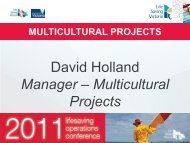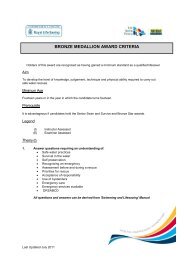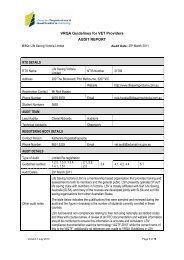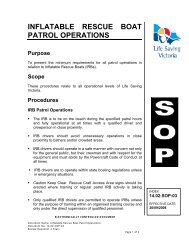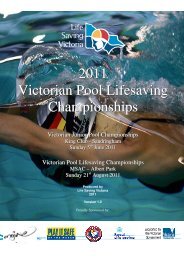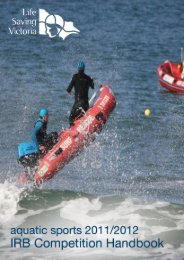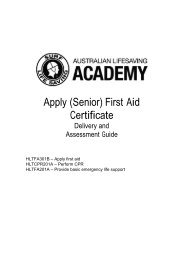Administering oxygen therapy - Life Saving Victoria
Administering oxygen therapy - Life Saving Victoria
Administering oxygen therapy - Life Saving Victoria
You also want an ePaper? Increase the reach of your titles
YUMPU automatically turns print PDFs into web optimized ePapers that Google loves.
SLSA Advanced Resuscitation Certificate<br />
Workbook<br />
Advanced Resuscitation Certificate/PUAEME003B Administer Oxygen in an Emergency Situation Surf <strong>Life</strong> <strong>Saving</strong> Australia | 1
Acknowledgements<br />
Produced by the SLSA National Education Resource<br />
Development Panel<br />
Peter Agnew – National <strong>Life</strong>saving Manager – SLSA<br />
Tim Ryder – National Education Co-ordinator - SLSA<br />
Craig Roberts – Operations Manager (<strong>Life</strong>saving and Education) – SLSNSW<br />
Bridget Judd – Education Officer - SLSNSW<br />
Glenn Ross – Training Consultant – SLSWA<br />
Rob O’Brien – Support Officer – <strong>Life</strong>saving Training – LSV<br />
Andrew Chubb – Education Advisor – SLSNSW<br />
Ben Whibley – Education & Training Officer – SLS Hunter Branch<br />
Adam Profke – Training and Education Development Officer – SLSQ<br />
Sharon Stewart – Darwin SLSC Chief Instructor – SLSNT<br />
Alex Mirowski – Education and Training Co-ordinator – SLST<br />
Nikki Chubb – Education Panel SLSNSW<br />
Aaron Tuckfield – Education Development Officer SLSSA<br />
Copyright Notice<br />
© Surf <strong>Life</strong> <strong>Saving</strong> Australia<br />
All rights reserved.<br />
This product has been developed for use within Surf <strong>Life</strong> <strong>Saving</strong> Australia. Copies may not<br />
be printed and/or reproduced by photocopying, scanning or any other methods for use,<br />
hire or resale within Australia or by any other organisation unless authorised by the<br />
National Education Co-ordinator.<br />
2 | Advanced Resuscitation Certificate/PUAEME003B Administer Oxygen in an Emergency Situation Surf <strong>Life</strong> <strong>Saving</strong> Australia
Surf <strong>Life</strong> <strong>Saving</strong> Australia<br />
ADVANCED RESUSCITATION<br />
CERTIFICATE<br />
PUAEME003B<br />
Administer Oxygen in an Emergency Situation<br />
Candidate Details:<br />
Name: D.O.B. / /<br />
Club/Service:<br />
Assessor:<br />
Date of Assessment: / /<br />
Advanced Resuscitation Certificate/PUAEME003B Administer Oxygen in an Emergency Situation Surf <strong>Life</strong> <strong>Saving</strong> Australia | 3
Contents<br />
Introduction<br />
Qualification Awarded …………………………………………………………….. 5<br />
Prerequisites ………………………………………………………………………… 5<br />
Recognition of Prior Learning ……………………………………………………… 6<br />
Self Help Activity Questions<br />
Why Use Oxygen?........... …………………………………………………………… 7<br />
The Components of Oxygen Resuscitation Equipment ..……………………….. 7<br />
<strong>Administering</strong> Oxygen Therapy ...................................………………………….. 8<br />
Setting up Oxygen Resuscitation Equipment ……………………………………. 9<br />
Equipment Maintenance ……………………………………………………………. 10<br />
<strong>Administering</strong> Suction (Optional) ……………..……………………………………. 10<br />
Automatic Oxygen-Powered Resuscitator (Optional) …………………………… 11<br />
Oropharyngeal Airways ……………………………………………………………. 12<br />
Personal Safety ……………………………………………………………………… 14<br />
Observation Checklist……………………………………………………………….. 15<br />
4 | Advanced Resuscitation Certificate/PUAEME003B Administer Oxygen in an Emergency Situation Surf <strong>Life</strong> <strong>Saving</strong> Australia
Section 1 – Introduction<br />
Welcome to the workbook for the SLSA Advanced Resuscitation Certificate. This<br />
workbook will provide you the learner with all the necessary information and activities in<br />
achieving competence in this course.<br />
What this guide contains<br />
The Advanced Resuscitation Certificate workbook has two sections:<br />
Section 1 - Introduction<br />
Section 2 - Self Help Activity Questions<br />
This section consists of a series of short answer questions. They are designed to<br />
reflect the knowledge required to demonstrate competence. These questions can be<br />
used as a home study resource or as discussion points during training sessions.<br />
Qualification Awarded<br />
A candidate who has demonstrated competence in PUAEME003B Administer Oxygen in<br />
an Emergency Situation will receive a Surf <strong>Life</strong> <strong>Saving</strong> Australia Advanced Resuscitation<br />
Certificate.<br />
Public Safety Statement of Attainment<br />
A candidate who has demonstrated competence in the SLSA Advanced Resuscitation<br />
Certificate is entitled to receive a statement of attainment for the unit of competency<br />
PUAEME003B Administer Oxygen in an Emergency Situation which is a competency<br />
recognised nationally under the Vocational Education and Training System. Appropriately<br />
qualified and endorsed assessors from a Registered Training Organisation (RTO) must<br />
assess this unit of competency.<br />
Prerequisites for the SLSA Advanced Resuscitation<br />
Certificate<br />
A candidate must:<br />
• Be a minimum of 15 years old on the date of assessment, and<br />
• Hold the unit of competency PUAEME001A Provide Emergency Care, OR<br />
• Hold a current SLSA Bronze Medallion/Certificate II in Public Safety (Aquatic Rescue),<br />
OR<br />
• Hold a current SLSA Senior First Aid Certificate (CPR component must have been<br />
updated within last 12 months)<br />
Assessment pathways<br />
The two major assessment pathways listed in the Assessment Guidelines for the Public<br />
Safety Training Package are:<br />
<br />
<br />
Recognition of Current Competence (RCC) – competency gained through prior<br />
learning, work experience or life experience.<br />
Assessing competence in an actual or simulated workplace environment.<br />
Assessment tools have been designed so that candidates can use either of these<br />
pathways to demonstrate competence. This means that assessors can draw on a<br />
combination of assessment methods to assess the candidate, depending on their current<br />
skills and knowledge.<br />
Advanced Resuscitation Certificate/PUAEME003B Administer Oxygen in an Emergency Situation Surf <strong>Life</strong> <strong>Saving</strong> Australia | 5
Recognition of Current Competence (RCC) and<br />
Recognition of Prior Learning (RPL)<br />
RCC and RPL acknowledge skills and knowledge obtained through:<br />
• Formal training (conducted by industry or educational institutions)<br />
• Work experience (informal training)<br />
• <strong>Life</strong> experience<br />
The main focus is on the learning outcomes of these experiences, not on how, when or<br />
where the learning occurred.<br />
All course participants must be advised of the opportunity to apply for RPL. SLSA has a<br />
number of RCC and RPL procedures that you can view on the SLSA website<br />
www.slsa.com.au. Should you wish to find out more about RCC and RPL within surf<br />
lifesaving refer to the RPL policy or speak to your training officer.<br />
Other Resources<br />
This is one of five publications that support the training and assessment for the SLSA<br />
Advanced Resuscitation Certificate. The other four publications are:<br />
Surf <strong>Life</strong> <strong>Saving</strong> First Aid and Emergency Care Manual<br />
This manual is a resource for candidates, trainers and assessors that contain<br />
information on skills and knowledge relating to first aid, spinal management, <strong>oxygen</strong><br />
equipment use and use of analgesic gases.<br />
Surf <strong>Life</strong> <strong>Saving</strong> Training Manual 32 nd Edition<br />
This manual is a resource for candidates, trainers and assessors that contain<br />
information on skills and knowledge relating to resuscitation.<br />
Trainer and Assessor Guide<br />
This guide is available to trainers and assessors and contains tools to deliver and<br />
assess this course.<br />
Assessment Portfolio This document will assist Candidates, Trainers and Assessors<br />
with the evidence needed to successfully record all documentation for assessment.<br />
6 | Advanced Resuscitation Certificate/PUAEME003B Administer Oxygen in an Emergency Situation Surf <strong>Life</strong> <strong>Saving</strong> Australia
Part 2 – Self Help Activity Questions<br />
Why use <strong>oxygen</strong>?<br />
1. List five conditions that may benefit from <strong>oxygen</strong>:<br />
a. _______________________________<br />
b. _______________________________<br />
c. _______________________________<br />
d. _______________________________<br />
e. _______________________________<br />
2. Which of the following statements about safety precautions when using <strong>oxygen</strong> is<br />
NOT true?<br />
a. Never use <strong>oxygen</strong> near an open flame (including cigarettes)<br />
b. Never use grease or oil with <strong>oxygen</strong> equipment<br />
c. When delivering a shock via defibrillator, make sure an <strong>oxygen</strong> mask is used<br />
d. None of the above<br />
The components of <strong>oxygen</strong> resuscitation equipment<br />
3. Name the parts below indicated with arrows<br />
_______________<br />
____________<br />
______________<br />
____________<br />
______________<br />
______________<br />
____________<br />
____________<br />
_______________<br />
_______________<br />
Advanced Resuscitation Certificate/PUAEME003B Administer Oxygen in an Emergency Situation Surf <strong>Life</strong> <strong>Saving</strong> Australia | 7
4. Give a brief explanation of a routine check of the following equipment<br />
Oxygen cylinder __________________________________________<br />
Sealing washer ___________________________________________<br />
Tubing __________________________________________________<br />
Masks __________________________________________________<br />
Case holding equipment ____________________________________<br />
<strong>Administering</strong> <strong>oxygen</strong> <strong>therapy</strong><br />
5. Match the Illness or injury and positions below for administering <strong>oxygen</strong> <strong>therapy</strong> to<br />
the following patients: (Draw connecting lines)<br />
Chest pains<br />
Supine, mouth to mask with <strong>oxygen</strong><br />
Conscious spinal<br />
Not used<br />
Unconscious patient<br />
Supine with legs raised<br />
Conscious suffering from shock<br />
Supine<br />
Unconscious non breathing<br />
Lateral position<br />
Hyperventilation<br />
Sitting up<br />
6. The concentration of <strong>oxygen</strong> in the patient’s lungs will be almost ……………%<br />
when the <strong>therapy</strong> setting of 8 litres per minute is utilised during mouth-to-mask<br />
resuscitation, and increase to greater than … … … … % if using 14/15 litres per<br />
minute and obtaining a good … … …<br />
8 | Advanced Resuscitation Certificate/PUAEME003B Administer Oxygen in an Emergency Situation Surf <strong>Life</strong> <strong>Saving</strong> Australia
7. Briefly describe four airbag checks?<br />
a. __________________________________________________________<br />
__________________________________________________________<br />
__________________________________________________________<br />
b. __________________________________________________________<br />
__________________________________________________________<br />
__________________________________________________________<br />
c. __________________________________________________________<br />
__________________________________________________________<br />
__________________________________________________________<br />
d. __________________________________________________________<br />
__________________________________________________________<br />
__________________________________________________________<br />
Setting up <strong>oxygen</strong> resuscitation equipment<br />
8. During airbag <strong>oxygen</strong> resuscitation, how many hands should be used to squeeze<br />
the airbag for an adult?<br />
______________________________________________________________<br />
9. How do you know when you have squeezed enough <strong>oxygen</strong> into the patient?<br />
______________________________________________________________<br />
______________________________________________________________<br />
10. If the <strong>oxygen</strong> bottle becomes depleted during resuscitation, you should continue<br />
using the airbag with the reservoir bag attached.<br />
TRUE/FALSE<br />
11. Complete the following information about <strong>oxygen</strong> <strong>therapy</strong>:<br />
A full ‘C’ cylinder (……………….L) will have the following approximate operational<br />
times:<br />
• ……………… minutes, with continuous use of <strong>oxygen</strong> <strong>therapy</strong> at 8 L per<br />
minute<br />
• 30 minutes, with continuous use of airbag (and <strong>oxygen</strong>) at …………… L per<br />
minute<br />
Advanced Resuscitation Certificate/PUAEME003B Administer Oxygen in an Emergency Situation Surf <strong>Life</strong> <strong>Saving</strong> Australia | 9
Equipment maintenance<br />
12. Briefly describe 3 protocols that should be followed after use by the airbag <strong>oxygen</strong><br />
resuscitator.<br />
a. ________________________________________________________<br />
________________________________________________________<br />
b. ________________________________________________________<br />
________________________________________________________<br />
c. ________________________________________________________<br />
________________________________________________________<br />
13. Which of the following is NOT the correct procedure for storage of <strong>oxygen</strong><br />
equipment:<br />
a. Do not store equipment in an enclosed space or cover it<br />
b. Spare <strong>oxygen</strong> equipment cylinders should be stored near <strong>oxygen</strong> equipment<br />
c. Oxygen equipment should be left with pressure in the system ready for an<br />
emergency situation to save time<br />
d. Cylinders that are half full or less can be used for training<br />
<strong>Administering</strong> Suction (Optional)<br />
14. Number the following procedures in the correct order for checking suction<br />
equipment:<br />
___ Turn suction lever fully on<br />
___ Remove catheter and fit to large tubing<br />
___ Test for suction against a soft part of one hand<br />
___ Turn suction lever fully on<br />
___ Remove large suction tubing from the case and hold near open end<br />
___ Test for suction again<br />
___ Turn lever off<br />
___ Return to case in original position<br />
___ Turn lever off<br />
10 | Advanced Resuscitation Certificate/PUAEME003B Administer Oxygen in an Emergency Situation Surf <strong>Life</strong> <strong>Saving</strong> Australia
15. Briefly describe three (3) procedures for administering suction?<br />
a. ___________________________________________________________<br />
___________________________________________________________<br />
b. ___________________________________________________________<br />
___________________________________________________________<br />
c. ___________________________________________________________<br />
___________________________________________________________<br />
16. Suction can be used on conscious patients ONLY if they are in the lateral position?<br />
TRUE/FALSE<br />
Automatic Oxygen-powered Resuscitator (Optional)<br />
17. What two (2) things should you check on an automatic <strong>oxygen</strong>-powered<br />
resuscitator during a routine check?<br />
a. __________________________________________________________<br />
b. __________________________________________________________<br />
18. Briefly outline the procedure for administering automatic <strong>oxygen</strong>-powered<br />
resuscitation:<br />
a. __________________________________________________________<br />
b. __________________________________________________________<br />
c. __________________________________________________________<br />
d. __________________________________________________________<br />
e. __________________________________________________________<br />
f. __________________________________________________________<br />
g. __________________________________________________________<br />
h. __________________________________________________________<br />
i. __________________________________________________________<br />
j. __________________________________________________________<br />
Advanced Resuscitation Certificate/PUAEME003B Administer Oxygen in an Emergency Situation Surf <strong>Life</strong> <strong>Saving</strong> Australia |11
19. Which of the following can occur when using an <strong>oxygen</strong>-powered resuscitator?<br />
a. An increased risk of over-inflation of the lungs<br />
b. An increased risk of damage to the middle ear due to changes in barometric<br />
pressure<br />
c. An increased risk of distension of the stomach<br />
d. All of the above<br />
Oropharyngeal airways<br />
20. When shouldn’t you use an OP airway?<br />
a. When the patient is conscious or semi-conscious<br />
b. When an airway of the correct size is not available<br />
c. When there is a large amount of vomit<br />
d. All of the above<br />
21. Complete the following sentence:<br />
Oropharyngeal (OP) airways are curved plastic devices that<br />
_________________________________________________________ in the<br />
_____________________________ patient by depressing the ____________<br />
and the _________________________ apart.<br />
22. Should an OP airway be used on children under 8 years of age?<br />
_______________________________________________________________<br />
23. Where should an OP airway be stored?<br />
_______________________________________________________________<br />
24. What should an OP airway be checked for?<br />
_______________________________________________________________<br />
25. What should be written on an OP airway used for training?<br />
_______________________________________________________________<br />
26. What should be used after training with an OP airway to prevent crossinfection?<br />
For how long?<br />
_______________________________________________________________<br />
12 | Advanced Resuscitation Certificate/PUAEME003B Administer Oxygen in an Emergency Situation Surf <strong>Life</strong> <strong>Saving</strong> Australia
27. After use on a patient, how should an OP airway be disposed?<br />
_______________________________________________________________<br />
28. To obtain the correct size OP airway what are the two measurement points?<br />
Place the flange _________________________________________________<br />
The curve of the airway is then _____________________________________<br />
29. The correct size airway is _________________________________________<br />
30. An OP airway must be only inserted into _____________________________<br />
or __________________________________________ patients.<br />
31. The OP airway should be inserted into an unconscious breathing patient in which<br />
position?<br />
_______________________________________________________________<br />
32. The OP airway can be inserted into an unconscious non-breathing patient in which<br />
positions?<br />
_______________________________________________________________<br />
33. What may be used to lubricate the OP airway before insertion?<br />
_______________________________________________________________<br />
34. Which way should the tip of the OP airway be pointing as inserted into the patient’s<br />
mouth?<br />
_______________________________________________________________<br />
35. After inserting the OP airway approximately 1/3 of its length into the casualty’s<br />
mouth, how much should you rotate it during the rest of the insertion?<br />
_______________________________________________________________<br />
36. Should Rescue Breathing continue during the insertion of an OP airway?<br />
_______________________________________________________________<br />
37. Should ECC continue during the insertion of an OP airway?<br />
_______________________________________________________________<br />
Advanced Resuscitation Certificate/PUAEME003B Administer Oxygen in an Emergency Situation Surf <strong>Life</strong> <strong>Saving</strong> Australia |13
38. Should the OP airway be rotated upon removal?<br />
_______________________________________________________________<br />
39. Name three situations when an OP airway should not be used<br />
a. __________________________________________________________<br />
b. __________________________________________________________<br />
c. __________________________________________________________<br />
40. In line with SLSA policy, what sizes of OP airways are to be kept available for<br />
usage?<br />
_____________________________________________________________<br />
Personal Safety<br />
41. What personal protection measures are recommended by SLSA?<br />
_______________________________________________________________<br />
_______________________________________________________________<br />
_______________________________________________________________<br />
_______________________________________________________________<br />
14 | Advanced Resuscitation Certificate/PUAEME003B Administer Oxygen in an Emergency Situation Surf <strong>Life</strong> <strong>Saving</strong> Australia
ARC Observation Checklist<br />
DRABCD – 1 Person<br />
Patient Assessment Card<br />
Timing of 30 Compressions and 2 breaths per cycle<br />
with a compression depth of 1/3 depth of chest<br />
Effectively administer breaths between compressions<br />
(ensuring no/minimal head tilt)<br />
Assess the area for Danger (Self, Patient, Bystanders) Approximately 2.5 cycles per minute<br />
Continually monitor patient for breathing and signs of<br />
Assess for response (conscious or unconscious) Effectively administer breaths between compressions life<br />
a)Conscious<br />
maintaining head tilt and jaw lift<br />
Manage vomiting or regurgitation<br />
Make patient comfortable<br />
Continually monitor patient for breathing and signs of<br />
Perform secondary assessment<br />
life<br />
“Signs of <strong>Life</strong>” Return<br />
b)Unconscious<br />
Manage vomiting or regurgitation<br />
“Cease Resuscitation”<br />
Call for assistance<br />
Important aspects<br />
Roll the patient on their side (placing arms across body Defibrillation<br />
Patient rolled into recovery position (unless suspected<br />
and out to side with leg bent – unless suspected spinal) “Assumed that the patient is over 8 years old or spinal)<br />
Maintain jaw support and patient care<br />
over 40kg in weight”<br />
Maintain head tilt and open airway effectively<br />
Assess Airway<br />
If a defibrillation unit and a trained operator arrives Patient Care is maintained at all times<br />
Assess Breathing (look, listen and feel) or signs of life Initial lifesaver continues CPR until the patient is<br />
prepared and unit is ready.<br />
b-1)Breathing Present<br />
Initial lifesaver obeys all instructions of defibrillation DRABCD – 2 Person Patient Assessment &<br />
Monitor airway, breathing and signs of life<br />
Perform secondary assessment<br />
b-2)Breathing Absent<br />
operator and works effectively as a team continuing<br />
CPR<br />
Resuscitation<br />
Patient Assessment Card<br />
Roll patient onto their back<br />
“Signs of <strong>Life</strong>” Return<br />
Both lifesavers assess the area for Danger (Self,<br />
Maintain jaw lift and provide head tilt (as per adult and “Cease Resuscitation”<br />
Patient, Bystanders)<br />
child. Neutral head position if an infant patient) Important aspects Both lifesavers assess for response (conscious or<br />
Deliver 2 breaths in 4 seconds - observe rise and fall of Patient rolled into recovery position (unless suspected unconscious)<br />
chest between breaths<br />
spinal)<br />
a)Conscious<br />
Check for signs of life – commence CPR if the patient Maintain head tilt and open airway effectively<br />
Make patient comfortable<br />
displays no signs of life<br />
“Signs of <strong>Life</strong>” Present and Breathing Returns<br />
Patient Care is maintained at all times<br />
Perform secondary assessment and manage injuries<br />
according to SLSA Training Manual 2<br />
Edition – Unit 4<br />
& 5 chapters.<br />
Roll patient back into recovery position<br />
b)Unconscious<br />
Monitor airway, breathing and signs of life<br />
Infant (CPR) Assessment Card<br />
nd<br />
Call for assistance/2 lifesaver coordinates a oxy-viva<br />
Perform secondary assessment<br />
“Patient has been administered 2 rescue breaths and/or defibrillator to arrive.<br />
Adult/Child (CPR) Assessment Card<br />
and assessed to display no signs of life.”<br />
“Signs of <strong>Life</strong>” Absent<br />
Airway operator supports the head maintaining head tilt<br />
and jaw lift at all times.<br />
“Patient has been administered 2 rescue breaths Commence CPR<br />
ECC operator manages the roll.<br />
and assessed to display no signs of life.”<br />
“Signs of <strong>Life</strong>” Absent<br />
Place 2 fingers in centre of chest as per SLSA Training<br />
nd<br />
Manual 2 Edition<br />
Airway operator and ECC operator roll the patient on<br />
their side effectively as a team (placing arms across<br />
Commence CPR<br />
Timing of 30 Compressions and 2 breaths per cycle body and out to side with leg bent – unless suspected<br />
Place 2 hands (option of 1 hand for a child) in centre of with a compression depth of 1/3 depth of chest. spinal)<br />
chest as per SLSA Training Manual 2 nd Edition<br />
Approximately 2.5 cycles per minute<br />
Maintain jaw lift and patient care<br />
Advanced Resuscitation Certificate/PUAEME003B Administer Oxygen in an Emergency Situation Surf <strong>Life</strong> <strong>Saving</strong> Australia | 15
ECC operator assesses Airway for foreign material and<br />
clears away any foreign material if present<br />
The airway operator assesses Breathing (Look, Listen,<br />
Feel)<br />
ECC operator assesses Breathing by observing<br />
movement of chest and upper abdomen<br />
b-1)Breathing Present<br />
Monitor airway, breathing and signs of life<br />
Perform secondary assessment<br />
b-2)Breathing Absent<br />
Airway Operator and ECC operator roll patient onto<br />
their back<br />
Airway operator maintains jaw support and provides<br />
head tilt (as per adult and child. Neutral head position<br />
if an infant patient)<br />
Airway operator delivers 2 breaths in 4 seconds -<br />
observe rise and fall of chest between breaths<br />
ECC operator simultaneously checks for signs of life –<br />
commence CPR if the patient displays no signs of life.<br />
Compression depth of 1/3 depth of chest demonstrated<br />
Airway operator delivers 2 inflations after every 30<br />
compressions<br />
Airway operator maintains head tilt and jaw lift<br />
Approximately 2.5 cycles per minute<br />
Airway operator and ECC operator rotate position at<br />
least every 2 minutes – minimal interruption of<br />
compressions occurs.<br />
Continually monitor patient for breathing and signs of<br />
life<br />
Manage vomiting or regurgitation<br />
“Signs of <strong>Life</strong>” Return<br />
“Cease Resuscitation”<br />
Important aspects<br />
Patient rolled into recovery position (unless suspected<br />
spinal)<br />
Maintain head tilt and open airway effectively<br />
Patient Care is maintained at all times<br />
“Signs of <strong>Life</strong>” Present & Breathing Returns<br />
Airway operator and ECC operator roll patient back<br />
onto their side appropriately<br />
Infant (CPR) Assessment Card<br />
“Patient has been administered 2 rescue breaths<br />
Open airway maintained<br />
and assessed to display no signs of life.”<br />
Monitor airway, breathing and signs of life<br />
“Signs of <strong>Life</strong>” Absent<br />
Perform secondary assessment<br />
Commence CPR<br />
ECC operator places 2 fingers in centre of chest as per<br />
Adult/Child (CPR) Assessment Card SLSA Training Manual 2 nd Edition<br />
“Patient has been administered 2 rescue breaths ECC operator delivers 30 Compressions at a rate of<br />
and assessed to display no signs of life.”<br />
approximately 100 compressions per minute pausing<br />
“Signs of <strong>Life</strong>” Absent after 30 th compression for airway operator to deliver 2<br />
Commence CPR<br />
breaths<br />
ECC operator places 2 hands (option of 1 hand for a Compression depth of 1/3 depth of chest demonstrated<br />
child) in centre of chest as per SLSA Training Manual Airway operator delivers 2 inflations after every 30<br />
nd<br />
2 Edition<br />
compressions (ensuring no/minimal head tilt)<br />
ECC operator delivers 30 Compressions at a rate of Approximately 2.5 cycles per minute<br />
approximately 100 compressions per minute pausing Airway operator and ECC operator rotate position at<br />
th<br />
after 30 compression for airway operator to deliver 2 least every 2 minutes – minimal interruption of<br />
breaths<br />
compressions occurs.<br />
Continually monitor patient for breathing and signs of<br />
life<br />
Manage vomiting or regurgitation<br />
“Signs of <strong>Life</strong>” Return<br />
“Cease Resuscitation”<br />
Important aspects<br />
Patient rolled into recovery position (unless suspected<br />
spinal)<br />
Maintain head tilt and open airway effectively<br />
Patient Care is maintained at all times<br />
(CPR) With Airbag Assessment Card<br />
“CPR” is in progress and have arrived with an Oxyviva,<br />
assist in performing CPR with airbag”<br />
(2) Notify of arrival of mask and airbag equipment<br />
(2) Notify of mask available for use & introduces mask<br />
maintaining seal<br />
(2) Introduce <strong>therapy</strong> tubing<br />
(2) Complete pre-operation checks (as per SLSA<br />
training Syllabus)<br />
(2) Notify of introduction of airbag<br />
Mark cylinder with contents, time, date, initials<br />
Scenarios Assessment Card<br />
“You have been called out to the following scene<br />
and need to assess the situation, rescue assess<br />
and treat the patient for any injuries or illnesses”<br />
Appropriateness of decision making was in coordinance<br />
with SLSA syllabus<br />
Type of decision making was relevant to incident<br />
Sufficiently compress Airbag to inflate patient’s lungs<br />
Maintain timing for RESCUE BREATHING/CPR as per<br />
SLSA Syllabus<br />
Perform CPR with airbag for 5 mins<br />
Manage vomiting and regurgitation<br />
“Cease Resuscitation”<br />
Important aspects<br />
Maintain head tilt<br />
16 | Advanced Resuscitation Certificate/PUAEME003B Administer Oxygen in an Emergency Situation Surf <strong>Life</strong> <strong>Saving</strong> Australia
Maintain open airway effectively<br />
Maintain effective seal<br />
Recommence RESCUE BREATHING/CPR (mouth to<br />
mask) if<br />
Airbag was faulty<br />
Maintain patient care at all times<br />
OP Airways Assessment Card<br />
Complete Basic Airway Management<br />
Posture the patient appropriately<br />
Head tilt/ jaw support – jaw thrust<br />
Visually inspect the airway for any fluids and/or foreign<br />
material<br />
Ensure the airway is clear from any fluids and/or<br />
foreign material<br />
Select appropriate size airway. Measure size by<br />
placing in line with the patients lips to the angle of the<br />
jaw<br />
Extend patients head and open patients’ mouth<br />
Insert the airway. With the top airway pointing towards<br />
the roof of the mouth, advance the airway between the<br />
teeth to approx 1/3 of its length, then rotate the airway<br />
180 degrees over the patients tongue.<br />
With top of airway now pointing down the pharynx,<br />
gently advance until flange is Pressing against the lips.<br />
Ensure the patients lower lip is not pinched between<br />
the teeth and airway.<br />
If the patient shows any signs of rejecting the airway,<br />
remove it immediately<br />
Documentation Assessment Card<br />
Record all information accurate and legible<br />
Only record facts<br />
Documentation is completed in INK only<br />
All mistakes are ruled out with a line<br />
Liquid paper not used<br />
Signed by the trainee<br />
SLSA Patrol Log/Incident Report Attached<br />
‘Crack’ cylinder (outlet must be turned away from sand<br />
persons)<br />
Assess sealing washer<br />
Insert bottle into yoke (ensuring inlet and outlet holes<br />
are lined up)<br />
Assess the contents of the <strong>oxygen</strong> cylinder (must be<br />
51% full)<br />
Assess pressure and flow of <strong>oxygen</strong><br />
Assess <strong>therapy</strong> nasks (cleanliness and serviceability)<br />
Assess resus masks (cleanliness and serviceability)<br />
Ensure Oropharyngeal airways are present and clean<br />
Check airbag for leaks and direction of air<br />
Check the function of membrane (O 2 exiting reservoir<br />
bag and entering air bag)<br />
Check for accessories (chalk/pen, gloves & 2 sealing<br />
washers)<br />
Drain <strong>oxygen</strong> system and check needle fall to zero<br />
The patient identification was appropriate<br />
The patient management was appropriate<br />
Sequence of actions was effective<br />
Signs and systems were treated correctly<br />
Communication of the patrol met with standards<br />
Decisions made appropriate to the circumstance<br />
Actions taken by the patrol were effective<br />
Actions taken by the patrol were efficient<br />
Communication was effective between the patrol group<br />
Communication was effective to other<br />
The appropriate equipment was used<br />
Oxyviva Check Assessment Card<br />
Remove plastic wrapping<br />
Advanced Resuscitation Certificate/PUAEME003B Administer Oxygen in an Emergency Situation Surf <strong>Life</strong> <strong>Saving</strong> Australia | 17
Surf <strong>Life</strong> <strong>Saving</strong> Australia<br />
Level 1, 1 Notts Avenue<br />
Locked Bag 2 Bondi Beach NSW 2026<br />
18 | Advanced Resuscitation Certificate/PUAEME003B Administer Oxygen in an Emergency Situation Surf <strong>Life</strong> <strong>Saving</strong> Australia


